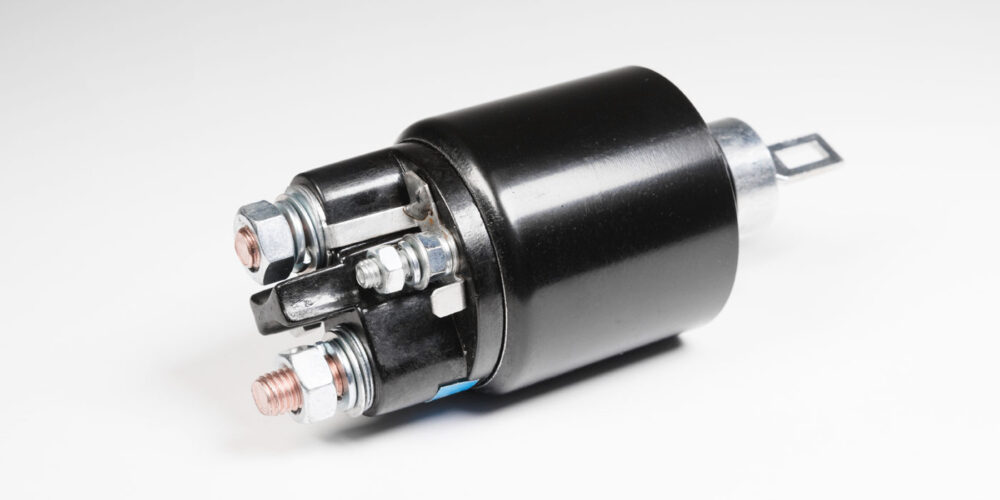In the automotive context, a solenoid converts electrical energy into mechanical work. It’s important to clarify this because from a scientific standpoint, a solenoid is defined as a type of electromagnet, with multiple different uses that ultimately aren’t relevant in the automotive space – nor would I be qualified to attempt an explanation that requires a deep understanding of physics.
But I can explain how an automotive solenoid works. Operation is based on electromagnetism, a concept that automotive technicians are very familiar with and learn early on with basic electrical theory.
Any time current passes through a conductor – in this case a wire – an electromagnetic field is generated. When the wire is wrapped tightly into multiple coils, the magnetic field is intensified. Since like poles repel each other magnetically, motion can be created by positioning a magnetic object in the generated field. This electrical fundamental is the basis of operation for solenoids, as well as electrical motors and alternators.
In the case of an electromechanical solenoid – the type we’re used to in the automotive context – the magnetic field acts upon a moveable armature, causing it to be pulled in a particular direction. The armature is connected either directly, or through a lever to another device, providing the mechanical movement to that device.
The advantage to solenoid operation is the speed with which a mechanical reaction can occur. One of the most common solenoids we’re used to is a starter solenoid. A look at the exploded view of a typical starter and solenoid (Figure 1) will help illustrate how a starter solenoid works.
Starter Solenoids
The starter solenoid has two functions, both of which use mechanical motion. When the windings in the solenoid are energized via the ignition switch circuit, the resulting magnetic force pulls the plunger into the solenoid. This causes the fork to throw the starter pinion outward to engage in the teeth on the engine flywheel. As the plunger reaches the end of its travel, it pushes together two large high-amperage contacts that allow the current from the battery to flow into the starter motor, causing it to rotate.
The starter solenoid is well-known by vehicle owners – even if they don’t know much else about cars – primarily due to their infamous reputation of causing a no-start problem. Also well-known is the “home” remedy to hit the solenoid or starter with a hammer to make it work. While this usually works for the first few times a problem occurs, it can easily damage the internal components of the solenoid or starter, and it’s not a recommended practice for this reason.
The common no-start symptoms related to a starter or its solenoid are:
- No noise at all when attempting to start the vehicle
- A clicking noise
- A deeper clunk sound
- The sound of the starter motor spinning but not the engine
When there’s no noise at all, the first thing to check is the starting circuit to make sure power is getting to the solenoid activation terminal.
A clicking noise can mean the solenoid is being energized, but unable to properly engage due to internal binding. However, this also is usually caused by a “dead” battery. A deep clunk sound indicates that the plunger is working properly and engaging the starter pinion into the flywheel, but current is not flowing into the starter, due to either a poor connection leading up to or within the solenoid or worn starter brushes.
If the starter motor alone spins, it means a problem with the mechanical action of the solenoid plunger, fork or starter pinion has prevented it from engaging the flywheel. The vibration from striking the starter can create a temporary solution to any of these problems, but temporary is the reality.
Other Solenoids
On today’s vehicles, there are many different types of solenoids. A push-and-pull solenoid is one that operates with a fixed range of travel, such as the starter solenoid described above. The plunger of the solenoid travels in one direction or the other (it may push, or it may pull) when energized, and a spring returns it to the non-energized position.
Another example of a push-and-pull solenoid is a trunk-release solenoid. Even though these are built into latch assemblies on most newer vehicles – and not so audibly intrusive – on older cars that featured trunk-release buttons on the dash you could hear the tell-tale clunk of the solenoid operating by pressing and releasing the button.
Power door locks utilize a solenoid that is considered a holding solenoid. By reversing the polarity, this type of solenoid will move in either direction, then remain in that position while unenergized until reverse polarity is applied.
Proportional Solenoids
Now it gets interesting. A proportional solenoid is one whose position can be controlled in a precise manner. The primary use for a proportional solenoid is to manage operation of pistons and valves for accurate control of fluid flow and pressure. For example, proportional solenoids are used in automatic-transmission valve bodies and for torque-converter lock-up control, fuel injectors, variable-valve-timing actuators and in antilock brake systems.
When compared to the basic electrical function of a push-pull or holding solenoid, proportional solenoids require a more advanced control. This control is pulse-width modulation (PWM), which is a method for controlling the amount of power sent to any given component. During PWM, the vehicle ECU continuously switches the power on and off in a circuit. The longer the power is on, the more power is sent to the circuit.
Determining the position of a PWM-controlled solenoid is achieved by the control unit monitoring the current flow through the solenoid. Along with all other forms of automotive technology, solenoids have evolved from basic electrical devices and control to highly precise actuators, relying on equally precise control to meet today’s demands of efficiency and performance. But they’re both still in use today.













